How mad can mad be? Is deep pessimism a form of madness? Very few paintings in the history of art have so puzzled and mystified, even perplexed viewers the way Hieoronymus Bosch’s Garden of Earthly Delights has. Six hundred years later, one can ask if we are still living the same folly. What is behind a blood-curdling message tinged with the comic and the placid?…..
No one definitively knows what the paintings mean. There is surmise and conjecture, in part because Bosch meant to convey multiple messages; however certain outlines are clear. As we move left to right, from Paradise to hell, we can see that the dynamics have hell have been altered. Usually, hell exists for the damned, a few lucky souls are saved and they can leave carrying a ticket for a promise of eternal life. Not so in the vision of Bosch, which moves through universal folly to endless damnation, without a hope of heaven. It is a world without Christ and without religion.
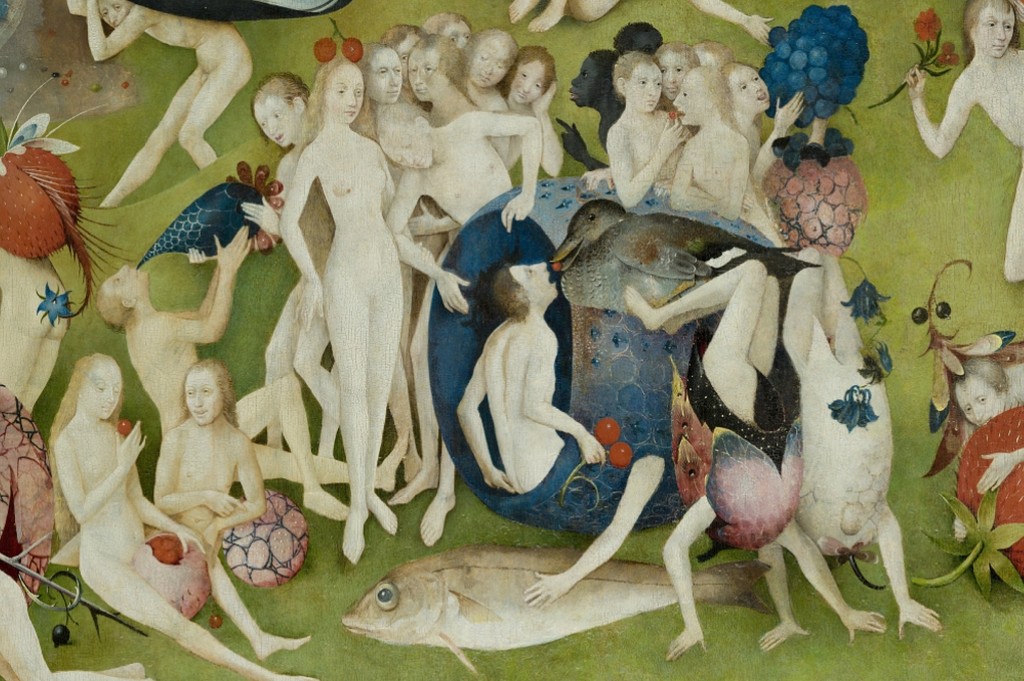
Detail. Central Panel. "Also possible is that Bosch is implying that even he himself will have to endure the travails of hell because he was one of the sinners in the central panel, a theory which concurs with Wilhelm's idea that Bosch was an Adamite. With all the symbolism entwined in the surreal Garden of Earthly Delights, it is difficult to understand Bosch's true meanings. Did he mean to pre-date Freud and Dalì, or did he just express his thoughts on panels? Even now, five hundred years after its painting, we do not understand all of the symbolism within The Garden of Earthly Delights;..." Read More: http://www.bbc.co.uk/dna/h2g2/A12737748 image: http://commons.wikimedia.org/wiki/File:Bosch,_Hieronymus_-_The_Garden_of_Earthly_Delights,_central_panel_-_Detail_duck_feeding_man_%28lower_left_side%29.jpg
Humankind is seen living in a home, or a ghetto for the insane, which it has built and equipped for its needs. It is ruining its intellect and its power of self-direction. In the end it will hand itself over to the powers of darkness and madness. Eternity will be a lunatic asylum. This, then, is a message of deep pessimism.
Since the Earth in this panel is fully populated, it suggests that it is a time following the expulsion of Adam and Eve from Eden. This idea is supported by a couple in the cave in the left-hand corner of the painting that may be Adam and Eve from the first panel. However it is unknown whether it is in a time before or after the Great Flood; some believe the man behind Adam is Noah, suggesting either a time before the great flood, or after, when mankind has reverted to their original ways: “Either way, this is clearly a time when God has been forgotten: men and women are frolicking about, the young men and women are mainly interested in kissing, embracing and stroking one another. It is notable that there are no children in this image; this demonstrates that they are going directly against God’s wishes of ‘Be fruitful and multiply’ (Genesis 1:28). Man has abandoned heavenly paradise for a garden of earthly delights.” Read More: http://www.bbc.co.uk/dna/h2g2/A12737748
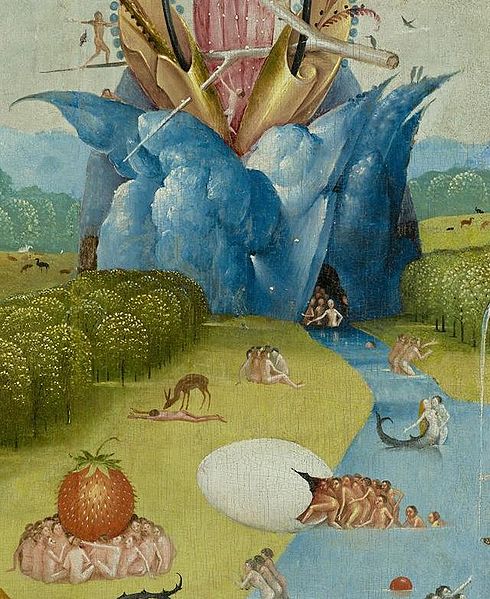
Detail. Gombrich:The earliest description of Bosch's Garden of Earthly Delights occurs in the travel diary of Antonio de Beatis when he saw the triptych in the Palace of Henry III on 30 July 1517. The tone of his description suggests entertainment rather than horror or anxiety, a frequent reaction to Bosch among the international aristocracy of the 16th century and prevalent even in the early 19th century. Recent interpretations have perhaps concentrated too much on the sexual element of the triptych and too little on the other theme of instability and impermanence inherent in the enjoyment of 'earthly delights'. Read More: http://www.gombrich.co.uk/showcom.php?id=24 image: http://polarbearstale.blogspot.com/2011/02/what-goes-on-in-egg.html
One theory, is that the painting is a partial representation of a repressed trauma on Bosch’s part.Who knows. possibly sexual abuse resulting in impulses that have vanished out of consciousness with for example, the animals fitted as an object of anxiety. Going from left to right. We see that the central panel can be read not so much about innocence but as the way be construct it. In the Paradise panel of the left the question is posed whether this purity is manufactures, glued and pinned together, a form of disavowal of Christian teachings that we are born in orginal sin, and the painting foretells the results of unconscious decisions to idealize the world. Also, given Bosch’s esotericism, Rosicrucian and perhaps Kabbalah; it is possible that the narrative was meant to flow from right to left in the Babylonian tradition.
“The Kabbalah teaches that this act of aligning ourselves with God is a process that takes place over many lifetimes. Before each birth, we are like a thread in a divine tapestry, a “curtain of souls.” The thread of our existence is interwoven with the threads of the All. Descending from the One, we are born into separation and duality. This descent and separation is a painful tearing of the fabric of our existence.
Before our soul descends into the world, we know everything there is to know; we know all the worlds, our reason for being, our destiny, and our connection to All That Is. Then, at birth, an angel touches our lips and this knowledge and our intimate connection to the Creator is forgotten. Compelled by our need for survival, we are drawn inexorably into the stream of life, focusing all our energy on obtaining nourishment, maintaining our physical safety, and mastering our earthly environment….
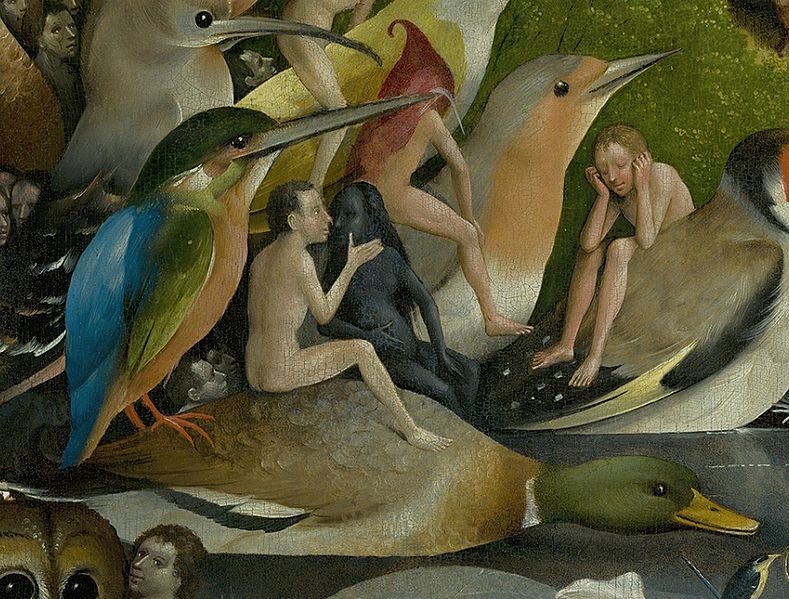
"This is what I cannot figure out. Is Bosch trying to draw a trajectory from panel to panel brought about by wrong choices? Or, is Bosch saying that the whole concept of delightful consumption itself is Hell? Because consumption itself can never fulfill the human person. Messianic Jew Simone Weil says in her book, Waiting on God, that one cannot both consume the paradoxical creation and the divine Creator at the same time. One must choose." Read More: http://dandelionsalad.wordpress.com/2010/06/20/the-concept-of-hell-in-the-art-work-of-hieronymus-bosch-by-rocket-kirchner/ image: http://en.wikipedia.org/wiki/File:Bosch,_Hieronymus_-_The_Garden_of_Earthly_Delights,_central_panel_-_Detail_Bird_and_Man_riding_a_duck.jpg
The angel who touches our lips and causes us to forget does not completely erase our memory. Faint awareness remains of what we once knew. Living w
this subtle awareness submerged within, we sense that something important has been lost.At the same time, there is often an unreality about this sense of loss. What could be missing? How could we begin to look for it? It is like the buried fortunes in fairy tales. The treasure has been buried so long that talk of its existence seems unbelievable. Nonetheless, despite attempts to ignore or dismiss it, memory lingers of our soul’s original state of oneness. Hidden but active, this memory exerts a powerful influence. …Read More: http://www.themessenger.info/content/index.php?option=com_content&view=article&id=36:the-path-of-kabbalah-pt-1&catid=29:spiritual-development&Itemid=29
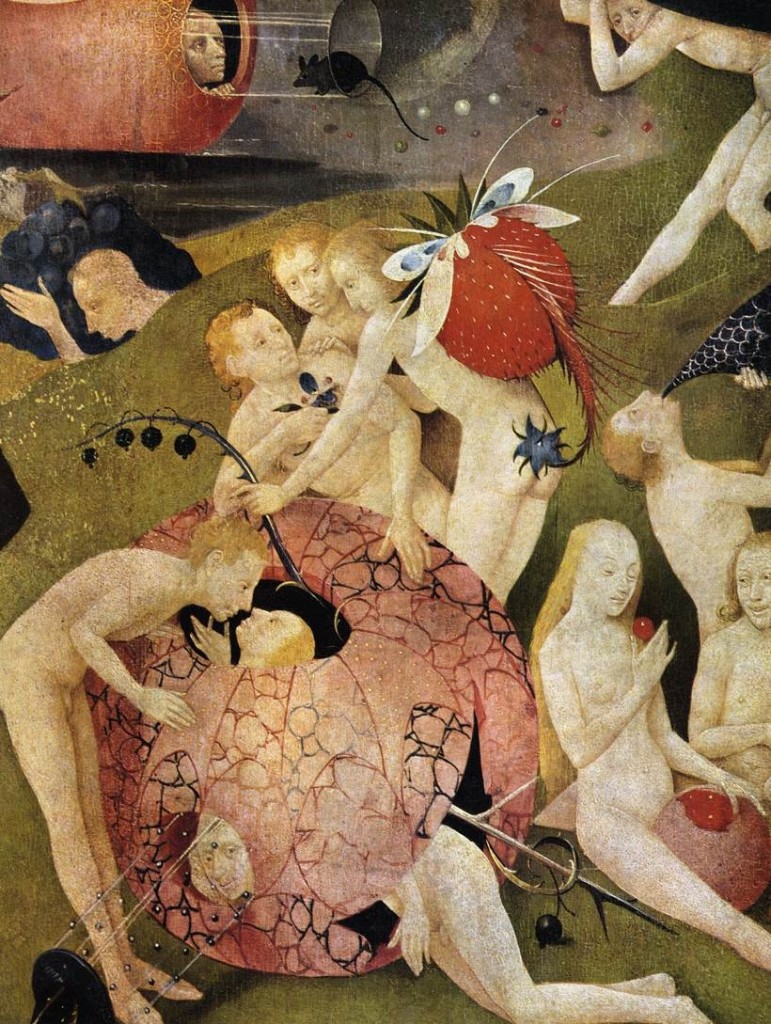
Alan Bass: The contradiction in Freud's argument can be resolved by understanding disavowal in terms of registration and repudiation of difference. The patients who resist interpretation register and repudiate the differentiating process implicit in every interpretation. The problem of resistance to interpretation expands the basic conception of the unconscious to include registration and repudiation of differentiating, processive reality. Freud's conception of an unconscious force that simultaneously differentiates, binds, and raises tension levels—Eros—demands integration with the theory of disavowal. This integration produces a theory of an inevitable trauma, an inevitable registration and repudiation of difference, as an essential element in psychoanalytic theories of mind, psychopathology, and treatment. Read More: http://www.sup.org/book.cgi?book_id=3828
ADDENDUM:
http://www.jstor.org/pss/750611
However, with Bosch nothing is simple: every theory has its contradiction. Wilhelm Fraenger views the work more positively than other critics. He states that the left-hand panel is not depicting the fall of man due to Eve’s tempting but rather God uniting man and woman. His interpretation of the second panel is somewhat different: he claims the people in the second panel were Adamites, a cult that wished to return to the innocence of Adam and Eve before the fall:
…are peacefully frolicking about the tranquil garden in vegetative innocence, at one with animals and plants and the sexuality that inspires them seems to be pure joy, pure bliss. This theory is very unusual, but may be based on Fraenger’s theory that Bosch belonged to the Adamites, and maybe The Garden of Earthly Delights is where he supports this theory. Read More: http://www.bbc.co.uk/dna/h2g2/A12737748 a
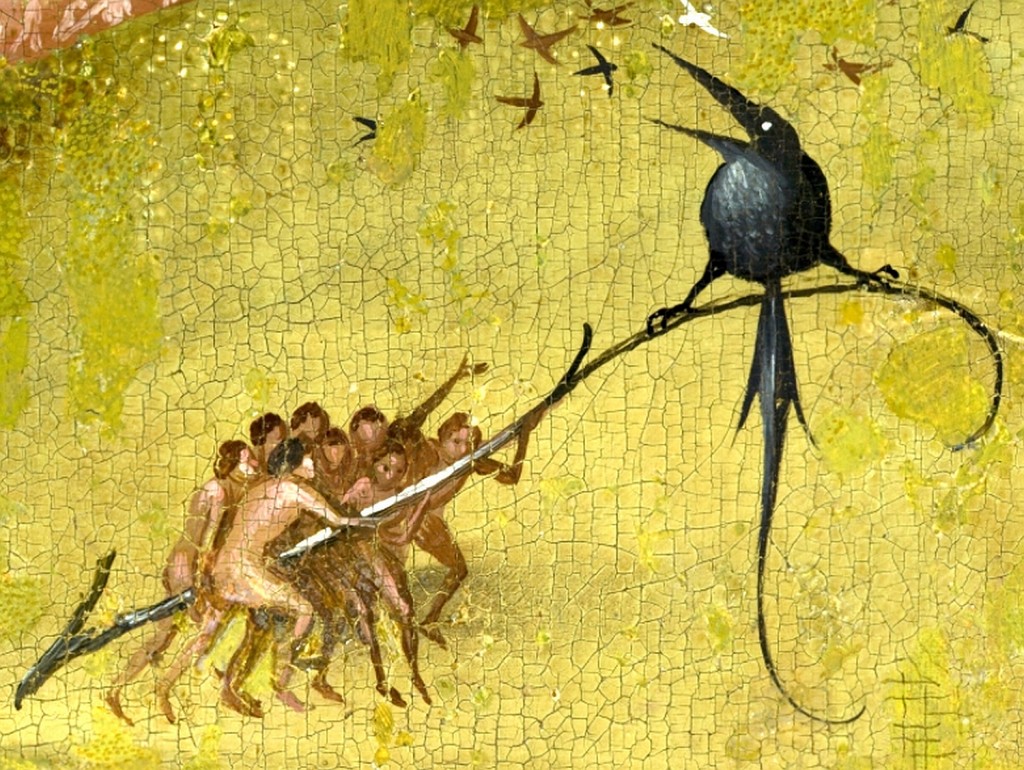
"And, last but not least, I have a book by Clement A. Wertheim Aymes called The Pictorial Language of Hieronymus Bosch, a book about the rosicrucian symbols hidden in Bosch's paintings and which makes them able to be 'read', and thereby communicate rosicrucian spiritual teachings and philosophy. The problem has been to make one's way through the stuff of legend and rumor to at least some reasonable sense of the underlying meaning of these matters and their relationship to the "Red Symbol" of the Hopi Prophecy. Easily a whole book could be written on this and related questions. Some readers, familiar with Umberto Eco's Foucault's Pendulum, may be aware of the strange, and frankly bizarre, material that can be found on "rosecrucianism". ---Read More: http://ipwebdev.com/hermit/mystb7.html image: http://commons.wikimedia.org/wiki/File:Bosch,_Hieronymus_-_The_Garden_of_Earthly_Delights,_central_panel_-_Detail-_Raven.jpg
Gombrich:Siguenca who described The Garden of Earthly Delights in 1605 as a symbolic interpretation of the vanity of worldly pleasures was basically right in his interpretation. The theme of the triptych is the Flood, signified by the rainbow in the outer panel which represents the covenant made by God with Noah after the Flood. The love-making, greed, unchasity, and unconcern illustrated in the central panel, are the scenes on earth that prompted God to destroy the world. The triptych should be called not ‘The Garden of Earthly Delights’but ‘The Lesson of the Flood’ described in the Gospel of St. Matthew: “But as the days of Noe were, so shall also the coming of the Son of man be. For as in the days that were before the flood they were eating and drinking, marrying and giving in marriage, until the day that Noe entered into the ark, And knew not until the flood came, and took them all all away, so shall also the coming of the Son of man be.” Read More: http://www.gombrich.co.uk/showcom.php?id=24
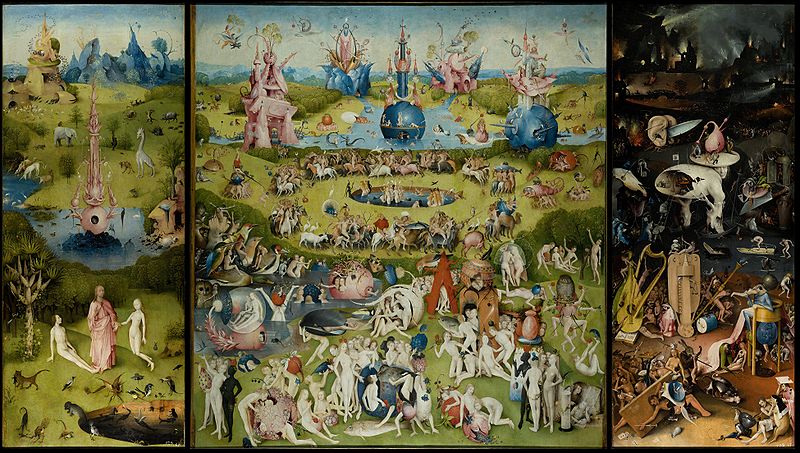
"Once man ate off the tree of knowledge, and since then the desire and need for earthly experience has been increasingly forced upon him. Earth has become his inheritance. Increasingly independent, liberated more and more from the guidance of the spiritual divine hierarchies, i.e. living in lands far away from God, abandoned by God, he too easily becomes a victim of error, and runs the danger of heaping one mistake upon another. And yet, it is only in this way that man can find his way ultimately to real freedom." Read More: http://www.american-buddha.com/cult.hieronymusbosch.1.htm
http://www.srmhp.org/0202/review-01.html
http://www.american-buddha.com/ramdass.snakepithumansuffering.htm





 COMMENTS
COMMENTS